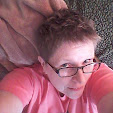Sure enough, sometime during the schoolyear, the opportunity came up to hear someone from Caifornia talk about AVID. I was right there. The "someone" was Kathy Deering, who, at that time, was one of AVID founder Mary Catherine Swanson's right-hand women. Only a few of us showed up to hear her, and I think I was the only classroom teacher. Within five minutes, I knew I wanted to teach AVID! It wasn't that Kathy was the world's greatest salesperson, although she is very charming and smart and "together." When I heard what the program was all about, it fit perfectly with everything I believed about students and achievement. It was all about the kids who are smart but who don't take the hard classes or go to college for one reason or another. I had studied and taught a lot of study skills over the years, and I had been a fairly successful athletic coach, too. Some of those skills fit perfectly with AVID.
 Before you could say T.D.Y., it was summertime and I was in San Diego with two colleagues, Beth Cunningham and Sandra Bruce, along with teams from six other schools in Germany and our superintendent, Larry Philpot, and his business manager, Bud Korth (also in photo left and below). We attended the 1992 AVID Summer Institute along with a few hundred other people on the University of San Diego campus. When we weren't in Tijuana, on the beach, drinking bird-bath size margaritas in Old Town, or betting on the horses at DelMar, we were learning about AVID right from the experts, Mary Catherine and her staff. In fact, Cyndy Bishop, her other right-hand woman (see photos below), taught me all about how to coordinate the program and teach AVID. We were given two HUGE binders (about 6") with everything you needed to run this program. That was it in those days. I don't think there were even page numbers on them.
Before you could say T.D.Y., it was summertime and I was in San Diego with two colleagues, Beth Cunningham and Sandra Bruce, along with teams from six other schools in Germany and our superintendent, Larry Philpot, and his business manager, Bud Korth (also in photo left and below). We attended the 1992 AVID Summer Institute along with a few hundred other people on the University of San Diego campus. When we weren't in Tijuana, on the beach, drinking bird-bath size margaritas in Old Town, or betting on the horses at DelMar, we were learning about AVID right from the experts, Mary Catherine and her staff. In fact, Cyndy Bishop, her other right-hand woman (see photos below), taught me all about how to coordinate the program and teach AVID. We were given two HUGE binders (about 6") with everything you needed to run this program. That was it in those days. I don't think there were even page numbers on them.
Beth, Cyndy, me and Sandra in San Diego, 1992
It was sink or swim when we came back to Germany for SY 92-93. I had one AVID class of nineteen freshmen (see photo below). I had given up all extra duties to devote myself to making this program work. I have to say we got great support from the district office and from AVID. They made frequent visits and we had a lot of meetings. The kids, the tutors, and I struggled to discover what AVID was. They resisted, the teachers resisted having them in honors classes, tutors came and went. But, when the consultants from the San Diego AVID Center visited us late in the year, according to one of my tutors, "Aliens invaded their little bodies and they became perfect little AVID students!" Well, we learned a lot, and the second year was 100% better and easier!

My first AVID class at Ansbach with Cyndy Bishop and Bud Korth
AVID "happened" to me at a time in my career when I was rather bored with the classroom and teaching English. It revitalized me, renewed me, and, to this day, I will say it was the best thing that happened to me in my career. It is still my favorite course to teach and program to coordinate and, by far, the most rewarding.




I remember first hearing about the program from you and thought it sounded wonderful and so glad you invested of yourself into it....rewarding and hard work!
ReplyDeleteWasn't that fun? I really enjoyed those two trips to SD. I just wish DoDDS would pay for GOOD training again, but it'll never happen again.
ReplyDeleteYour article was great.
What fun this was to read. A couple of minor things. The first binder did have page numbers -- I was very proud of the method, i.e. each section was numbered separately so we could add pages and not have to renumber the entire binder! Actually Kentucky and Missouri adopted AVID the year before DoDDS, but you were almost first, and there will NEVER be a more competent, enthusiastic group than those of DoDDS!
ReplyDeleteMary Catherine
Well, I noticed that MC already corrected you!! Wait...you mean it WASN'T my personality that hooked you??!! (lol)Are you writing a book? I have always thought you should, but I thought it would be your Italy blog. Maybe that, too?
ReplyDelete